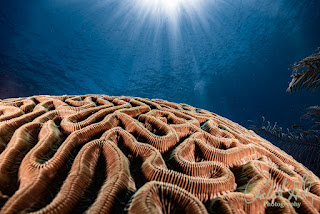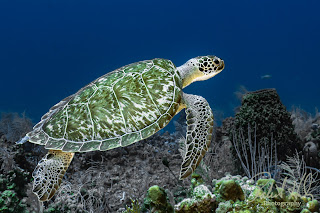How to Use Lightroom AI to Fix Blue Skin, Pink Sand & Unrealistic Backgrounds in Your Underwater Portraits
By Robert Herb – Empowering Underwater Photographers Since 1978
Have you ever snapped a perfect underwater selfie or caught your dive buddy mid-swim, only to find their skin glowing with an unnatural blue or a vibrant reef bed turned bubblegum pink? You're not alone in facing this challenge. These strange color shifts can be pretty frustrating, even for experienced underwater photographers. Whether you're capturing action shots of dive instructors, taking portraits of marine models, or just sharing the joy of your dive experiences with friends, it's disheartening when the colors in your photos don't look quite right.
Fortunately, advancements in photo editing technology have made it easier than ever to correct these issues. In this post, we'll explore how to leverage the latest AI-powered tools available in Adobe Lightroom Classic 14.4 and Lightroom Mobile 9.4. These tools can help you correct uneven skin tones, eliminate haze, and create realistic underwater portraits that truly capture the beauty you saw underwater. Features like Select People, Color Mixer, and Luminance Range Masks enable Lightroom to accurately identify human subjects, both on land and underwater, and provide precise, intelligent corrections. This means you can now achieve professional-quality edits with ease, even if you're new to photo editing.
By mastering these tools, you can ensure your underwater images look natural and vibrant, capturing the true essence of your diving adventures. So, whether you're aiming for flawless skin tones, crisp backgrounds, or just want your photos to pop with authentic color, these Adobe Lightroom features are here to help you enhance your underwater photography skills and preserve the magic of your dives.
Let's dive into 5 essential AI-powered workflows to make
your diver portraits vibrant, clean, and human again.
🛠 Example 1: Fixing
"Blue Diver Syndrome" with Select People AI
Problem: Your dive buddy appears to have stepped out of Avatar, with icy blue skin and purple lips, likely due to depth, lighting, or white
balance errors.
Steps:
- Open
image in the Develop Module
🔁 Shortcut: D - Open
the Masking Panel
🔁 Shortcut: Shift + W - Click "Select
People" → Choose "Entire Person" or just "Face Skin."
- Add Temp
(+15 to +25) and Tint (+10 to +15) to shift skin back toward
natural tones.
- Optionally
reduce Texture (-10) if the skin looks grainy or water-beaded.
✅ Result: The diver's skin
tone appears more natural—tan or rosy instead of cobalt—and stands out from the
water around them.
🛠 Example 2: Removing
Unrealistic Pink Sand or Backgrounds Using Color Mixer
Problem: Sandy bottoms or soft coral reflect harsh
strobe light, turning your background an unnatural shade of magenta or
cotton-candy pink.
Steps:
- Scroll
to the Color Mixer Panel
🔁 Shortcut: H (when hovering over a Hue slider) - Use
the Targeted Adjustment Tool (TAT) on the pink area to identify the
offending hue.
- Reduce
the Hue (shift magenta towards orange), or lower the Saturation
of that range.
- Switch
to Luminance and reduce the brightness of the pink/magenta if it still
draws attention.
✅ Result: The sand looks
clean and natural, with subtle pinks balanced into neutral tones. Your subject
is no longer lost in a Technicolor haze.
🛠 Example 3: Enhancing
Portraits with Background Separation via Luminance Masking
Problem: A diver portrait has good lighting, but the
background is flat or distracting. How do you make the person pop?
Steps:
- Add a Luminance
Range Mask
🔁 Add Mask → Luminance Range - Target
the midtones or highlights behind your subject (use eyedropper).
- Apply Dehaze
(+10) and Clarity (-15) to gently soften the background.
- On the
diver's own mask (via Select People), raise Texture and Sharpness.
✅ Result: Your subject
stays crisp and sharp, while the background fades into a soft, natural
gradient—almost like a depth-of-field effect.
🛠 Example 4: Correcting
Skin Luminance & Softness with Local Adjustments
Problem: Even with proper color balance, divers often
look pale, blotchy, or plasticky due to poor luminance separation.
Steps:
- Use Select
People → Face Skin and Body Skin (Lightroom AI will auto-detect both).
- In the
Local Adjustments, tweak:
- Exposure
(+0.1 to +0.3) if skin appears underlit
- Contrast
(+5 to +10) for facial definition
- Luminance
Noise Reduction (+20) if skin looks rough
- Optional:
Add Vibrance (+5) to enhance subtle skin tone variations without
oversaturating the image.
✅ Result: Faces and bodies
look vibrant but smooth, like they belong on land, not in an alien world.
🛠 Example 5: Lightroom
Mobile Touch-Ups Between Dives
Problem: You're on the boat, reviewing photos on your
tablet. A selfie with your buddy looks washed out or "foggy."
Steps:
- Open
the image in Lightroom Mobile v9.4
- Tap
the person → Masking > Select People (now supported on mobile
too!)
- Use Color
→ Increase Temp (+10), add Vibrance (+8), reduce Highlights
(-10)
- Add a
second Background Mask and reduce Dehaze (-10) to soften the
water
✅ Result: Your selfie
looks sharp, warm, and professional, even before you surface.
📸 Supported File Formats
To make full use of these AI tools:
|
Tool |
Lightroom Classic |
Lightroom Mobile |
Compatible Formats |
|
Select People AI |
✅ Yes (v14.0+) |
✅ Yes (v9.3+) |
RAW (DNG, CR3, ARW), JPG, HEIC |
|
Color Mixer |
✅ Yes |
✅ Yes |
All formats, including JPG |
|
Luminance Range Mask |
✅ Yes |
✅ Yes |
RAW and JPG |
|
Dehaze/Texture |
✅ Yes |
✅ Yes |
All formats |
|
Select Background |
✅ Yes |
✅ Yes |
RAW and JPG |
Tip: While RAW formats like DNG or CR3 provide the
best results for masking and tonal recovery, these features also work on
JPEGs, with slightly less dynamic range.
Final Thoughts: Make Your Divers Look Like Themselves
Again
This blog isn't just about fixing technical errors—it's about restoring the human touch in your underwater portraits. When Oceanic Explorers take pictures beneath the waves, each shot becomes a personal story. You want your friends, family, and dive professionals to see vibrant, expressive, and lively images—photos that capture the energy and emotion of the moment, rather than looking like mere sea creatures.
Thanks to Lightroom's latest AI tools, achieving this level of realism and warmth has become easier than ever, even in the most challenging shooting conditions. Whether you're processing your photos on the boat between dives or refining your images back at your desktop, these advanced workflows empower you to bring out the true essence of your underwater subjects. They help you add depth, color accuracy, and a genuine sense of atmosphere, making every portrait not just a picture, but a vivid story you'll cherish.
🐠 Ready to Dive Deeper?
Follow my weekly blog at Robert Herb Photography Blog
Share your results using #RobertHerbPhotography
🧭 What's Next?
🟦 Have you tried the new AI Tools yet? Share your edits using #RobertHerbPhotography.
🟦 Want to see these workflows in action? Sign up for my upcoming training course at RobertHerb.com or reach out at bob@robertherb.com
🟦 And don't forget—new blogs drop weekly at Robert Herb Photography Blog
Until next time… dive deep, shoot smart, and let Lightroom bring your vision to the surface.
– Bob Herb
Robert Herb Photography
Empowering Underwater Photographers Since 1978
Written by Robert Herb – Empowering underwater photographers to capture and enhance the beauty of our oceans.
Stay tuned for more in-depth insights into underwater photography. Let's dive deeper into the art and craft of capturing the marine world! If you have any comments or suggestions, I'd love to hear them.
Get ready for an exciting underwater photography adventure! For more details on my upcoming online training course, check out my "Training" page at RobertHerb.com or email me at bob@robertherb.com.
Sincerely,
Bob Herb
|
|





Comments
Post a Comment
Please let me know your comments.